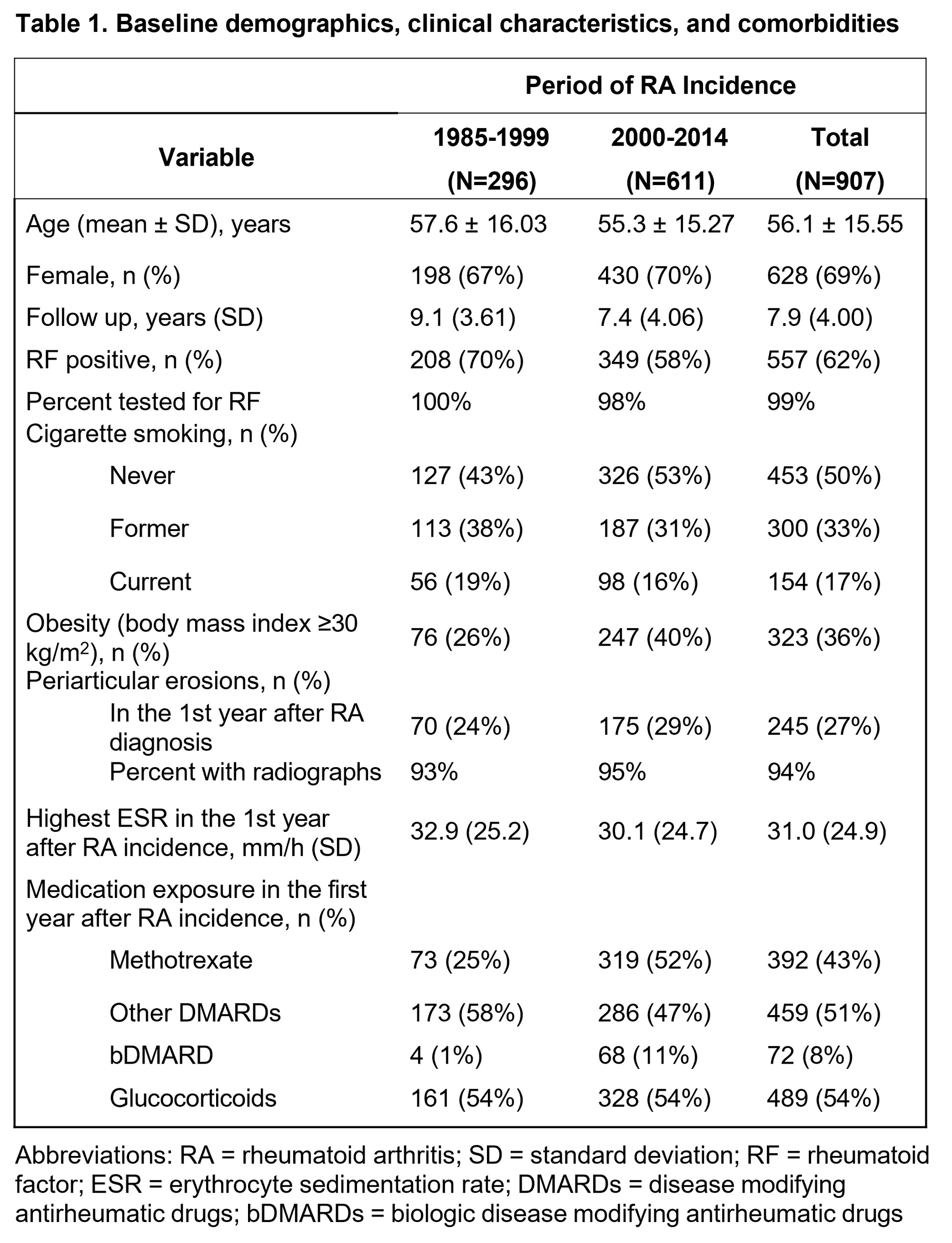Session Information
Date: Monday, November 13, 2023
Title: (1264–1307) RA – Diagnosis, Manifestations, and Outcomes Poster II
Session Type: Poster Session B
Session Time: 9:00AM-11:00AM
Background/Purpose: Extraarticular manifestations of rheumatoid arthritis (ExRA) are associated with increased disease burden and mortality. They are also common, affecting about half of patients with RA. Two primary risk factors for developing ExRA include high disease activity and seropositivity.Given advancements in RA management in the last two decades, epidemiologic data indicating an increasing incidence of seronegative RA, and lack of recent population-based epidemiologic studies evaluating ExRA over time, it is unclear if either the frequency of ExRA or mortality associated with ExRA has changed in recent years. This study aims to assess changes in the cumulative incidence of ExRA and associated mortality risk.
Methods: Trends in ExRA occurrence were evaluated using a population-based inception cohort. All adult patients with incident RA from 1985 through 2014 meeting the 1987 American College of Rheumatology criteria were included. Patients were divided into two cohorts based on the incidence date of RA, 1985-1999 and 2000-2014. Patients were followed until the earlier of death, migration from the region, or 12/31/2000 (for patients with incident RA from 1985-1994), 12/31/2008 (for patients with incident RA from 1995-2007), or 10/15/2022 (for patients with incident RA from 2008-2014). The occurrence of ExRA was determined by manual chart review. The 10-year cumulative incidence was estimated for each ExRA in both cohorts. Cox proportional hazard models were used to determine associations between specific demographic and RA disease characteristics and ExRA and between ExRA and mortality.
Results: A total of 907 patients were included in this study. There were 296 in the 1985-1999 cohort and 611 in the 2000-2014 cohort (table 1). The earlier cohort had a median follow up of 9.5 years (interquartile range [IQR] 6.7-12.0) and the later cohort had a median follow up of 7.4 years (IQR 4-10.3 years). The 10-year cumulative incidence of any ExRA decreased significantly between the earlier and later cohorts (45.1% vs 31.6%, p< 0.001; table 2 and figure 1). This was largely driven by significant declines in subcutaneous rheumatoid nodules (30.9% vs 15.8%, p< 0.001) and non-severe ExRA (41.4% vs 28.8%, p=0.001). Several risk factors for the development of any ExRA were identified, including RF positivity (hazard ratio [HR] 2.02, 95% confidence interval [CI] 1.43-2.86), current smoking (HR 1.61, 95% CI 1.10-2.34), and erosions (HR 1.46, 95% CI 1.05-2.04). Mortality was increased in patients with either non-severe (HR 1.83, 95% CI 1.18-2.85) or severe ExRA (HR 3.05, 95% CI 1.44-6.49).
Conclusion: The incidence of ExRA has decreased over time. Despite improvements in RA therapeutics and management strategies, mortality remains increased in patients with ExRA.
To cite this abstract in AMA style:
Kimbrough B, Crowson C, Davis J, Matteson E, Myasoedova E. Decline in Incidence of Extraarticular Manifestations of Rheumatoid Arthritis: A Population-Based Cohort Study [abstract]. Arthritis Rheumatol. 2023; 75 (suppl 9). https://acrabstracts.org/abstract/decline-in-incidence-of-extraarticular-manifestations-of-rheumatoid-arthritis-a-population-based-cohort-study/. Accessed .« Back to ACR Convergence 2023
ACR Meeting Abstracts - https://acrabstracts.org/abstract/decline-in-incidence-of-extraarticular-manifestations-of-rheumatoid-arthritis-a-population-based-cohort-study/



